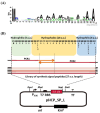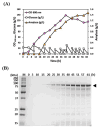Design of fully synthetic signal peptide library and its use for enhanced secretory production of recombinant proteins in Corynebacterium glutamicum
- PMID: 39285401
- PMCID: PMC11406804
- DOI: 10.1186/s12934-024-02516-9
Design of fully synthetic signal peptide library and its use for enhanced secretory production of recombinant proteins in Corynebacterium glutamicum
Abstract
Background: Corynebacterium glutamicum is an attractive host for secretory production of recombinant proteins, including high-value industrial enzymes and therapeutic proteins. The choice of an appropriate signaling peptide is crucial for efficient protein secretion. However, due to the limited availability of signal peptides in C. glutamicum, establishing an optimal secretion system is challenging.
Result: We constructed a signal peptide library for the isolation of target-specific signal peptides and developed a highly efficient secretory production system in C. glutamicum. Based on the sequence information of the signal peptides of the general secretion-dependent pathway in C. glutamicum, a synthetic signal peptide library was designed, and validated with three protein models. First, we examined endoxylanase (XynA) and one potential signal peptide (C1) was successfully isolated by library screening on xylan-containing agar plates. With this C1 signal peptide, secretory production of XynA as high as 3.2 g/L could be achieved with high purity (> 80%). Next, the signal peptide for ⍺-amylase (AmyA) was screened on a starch-containing agar plate. The production titer of the isolated signal peptide (HS06) reached 1.48 g/L which was 2-fold higher than that of the well-known Cg1514 signal peptide. Finally, we isolated the signal peptide for the M18 single-chain variable fragment (scFv). As an enzyme-independent screening tool, we developed a fluorescence-dependent screening tool using Fluorescence-Activating and Absorption-Shifting Tag (FAST) fusion, and successfully isolated the optimal signal peptide (18F11) for M18 scFv. With 18F11, secretory production as high as 228 mg/L was achieved, which was 3.4-fold higher than previous results.
Conclusions: By screening a fully synthetic signal peptide library, we achieved improved production of target proteins compared to previous results using well-known signal peptides. Our synthetic library provides a useful resource for the development of an optimal secretion system for various recombinant proteins in C. glutamicum, and we believe this bacterium to be a more promising workhorse for the bioindustry.
Keywords: Corynebacterium glutamicum; Library screening; Sec-dependent pathway; Secretion; Synthetic signal peptide.
© 2024. The Author(s).
Conflict of interest statement
The authors declare no competing interests.
Figures








Similar articles
-
Development of a new platform for secretory production of recombinant proteins in Corynebacterium glutamicum.Biotechnol Bioeng. 2016 Jan;113(1):163-72. doi: 10.1002/bit.25692. Epub 2015 Sep 8. Biotechnol Bioeng. 2016. PMID: 26134574
-
Use of a Sec signal peptide library from Bacillus subtilis for the optimization of cutinase secretion in Corynebacterium glutamicum.Microb Cell Fact. 2016 Dec 7;15(1):208. doi: 10.1186/s12934-016-0604-6. Microb Cell Fact. 2016. PMID: 27927208 Free PMC article.
-
Development of a secretory expression system with high compatibility between expression elements and an optimized host for endoxylanase production in Corynebacterium glutamicum.Microb Cell Fact. 2019 Apr 17;18(1):72. doi: 10.1186/s12934-019-1116-y. Microb Cell Fact. 2019. PMID: 30995928 Free PMC article.
-
Protein secretion in Corynebacterium glutamicum.Crit Rev Biotechnol. 2017 Jun;37(4):541-551. doi: 10.1080/07388551.2016.1206059. Epub 2016 Oct 13. Crit Rev Biotechnol. 2017. PMID: 27737570 Review.
-
Expression of recombinant protein using Corynebacterium Glutamicum: progress, challenges and applications.Crit Rev Biotechnol. 2016 Aug;36(4):652-64. doi: 10.3109/07388551.2015.1004519. Epub 2015 Feb 25. Crit Rev Biotechnol. 2016. PMID: 25714007 Review.
Cited by
-
Signal Peptides: From Molecular Mechanisms to Applications in Protein and Vaccine Engineering.Biomolecules. 2025 Jun 18;15(6):897. doi: 10.3390/biom15060897. Biomolecules. 2025. PMID: 40563537 Free PMC article. Review.
-
Recombinant DNA the Bio-Revolution, Between Promise, Hurdles, and Achievements.Int J Mol Sci. 2025 Jul 10;26(14):6611. doi: 10.3390/ijms26146611. Int J Mol Sci. 2025. PMID: 40724860 Free PMC article.
References
-
- Becker J, Rohles CM, Wittmann C. Metabolically engineered Corynebacterium glutamicum for bio-based production of chemicals, fuels, materials, and healthcare products. Metab Eng. 2018;50:122–41. - PubMed
-
- Zha J, Zhao Z, Xiao Z, Eng T, Mukhopadhyay A, Koffas MAG, Tang YJ. Biosystem design of Corynebacterium glutamicum for bioproduction. Curr Opin Biotech. 2023;79:102870. - PubMed
-
- Choi JW, Jeon EJ, Jeong KJ. Recent advances in engineering Corynebacterium glutamicum for utilization of hemicellulosic biomass. Curr Opin Biotech. 2019;57:17–24. - PubMed
-
- Lee SM, Jeong KJ. Advances in synthetic biology tools and engineering of Corynebacterium glutamicum as a platform host for recombinant protein production. Biotechnol Bioproc E. 2023;28(6):962–76.
-
- Freudl R. Beyond amino acids: Use of the Corynebacterium glutamicum cell factory for the secretion of heterologous proteins. J Biotechnol. 2017;258:101–9. - PubMed
MeSH terms
Substances
Grants and funding
LinkOut - more resources
Full Text Sources
Molecular Biology Databases
Research Materials

